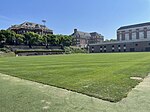Dayton Project

The Dayton Project was a research and development project to produce polonium during World War II, as part of the larger Manhattan Project to build the first atomic bombs. Work took place at several sites in and around Dayton, Ohio. Those working on the project were ultimately responsible for creating the polonium-based modulated neutron initiators which were used to begin the chain reactions in the atomic bombs. The Dayton Project began in 1943 when Monsanto's Charles Allen Thomas was recruited by the Manhattan Project to coordinate the plutonium purification and production work being carried out at various sites. Scientists at the Los Alamos Laboratory calculated that a plutonium bomb would require a neutron initiator. The best-known neutron sources used radioactive polonium and beryllium, so Thomas undertook to produce polonium at Monsanto's laboratories in Dayton. While most Manhattan Project activity took place at remote locations, the Dayton Project was located in a populated, urban area. It ran from 1943 to 1949, when the Mound Laboratories were completed in nearby Miamisburg, Ohio, and the work moved there. The Dayton Project developed techniques for extracting polonium from the lead dioxide ore in which it occurs naturally, and from bismuth targets that had been bombarded by neutrons in a nuclear reactor. Ultimately, polonium-based neutron initiators were used in both the gun-type Little Boy and the implosion-type Fat Man used in the atomic bombings of Hiroshima and Nagasaki respectively. The fact that polonium was used as an initiator was classified until the 1960s, but George Koval, a technician with the Manhattan Project's Special Engineer Detachment, penetrated the Dayton Project as a spy for the Soviet Union.
Excerpt from the Wikipedia article Dayton Project (License: CC BY-SA 3.0, Authors, Images).Dayton Project
Runnymede Road,
Geographical coordinates (GPS) Address Nearby Places Show on map
Geographical coordinates (GPS)
| Latitude | Longitude |
|---|---|
| N 39.724722222222 ° | E -84.179444444444 ° |
Address
Runnymede Road 799
45419
Ohio, United States
Open on Google Maps




